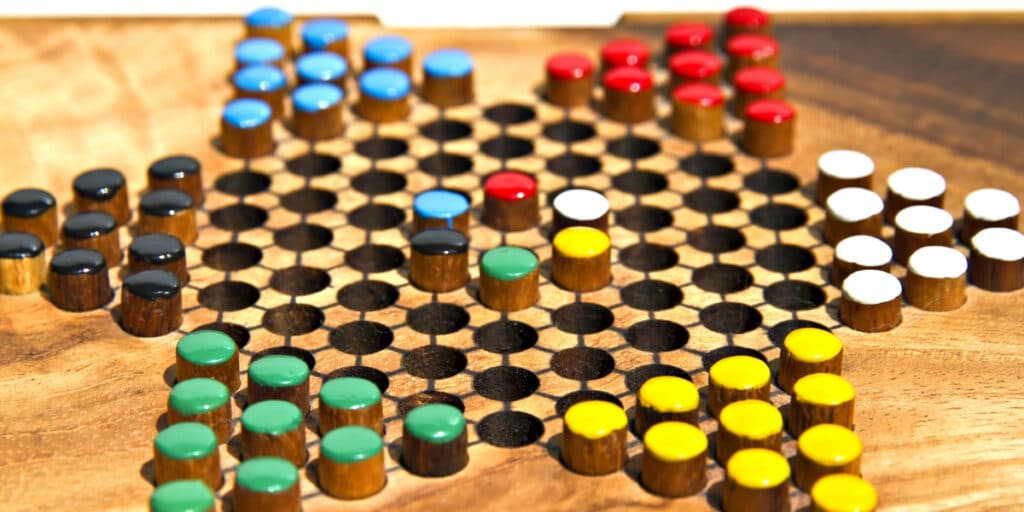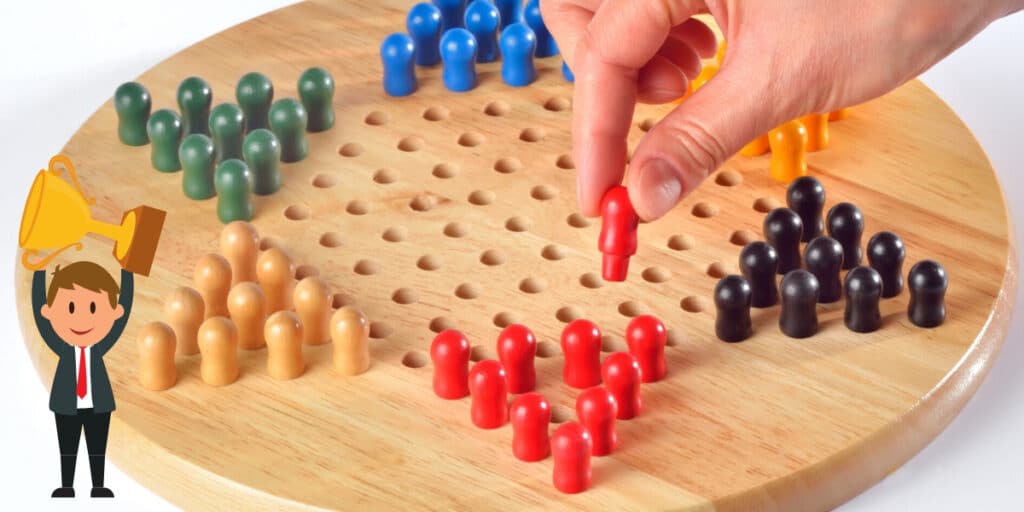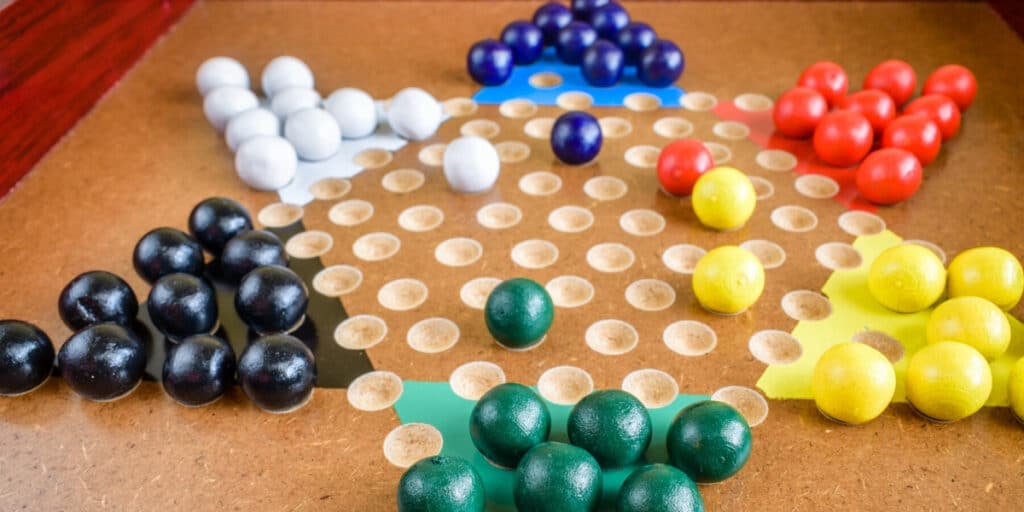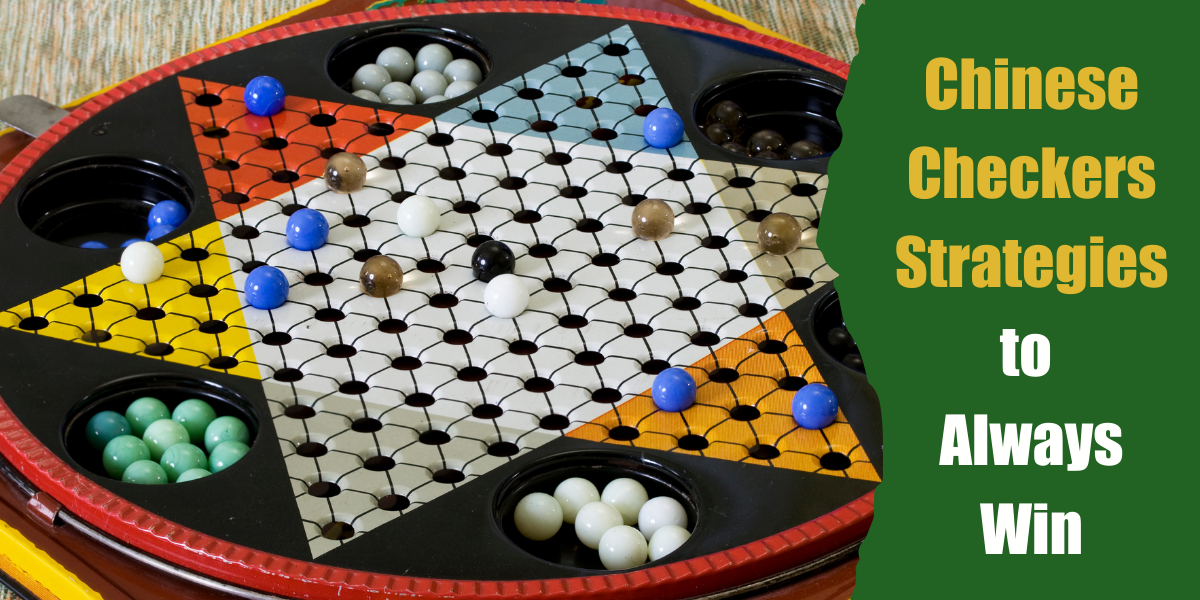Okay folks, you’re smack dab in the middle of a game of Chinese Checkers and you’re in need of a Chinese checkers strategy. Is there such a thing?
You wipe away the sweat beading on your brow, your body is hunched tensely over the board as you look desperately for your next move.
The room closes in. The air is still and hot. The stakes are high.
Our answer to that question is a resounding, Yes. There is such a thing as strategy in Chinese Checkers.
Fear not, we at Bar Games 101 have compiled a list of strategies and gameplay for:
10 Chinese Checkers Strategies to Always Win.

Before you begin, remind yourself that first and foremost, you are playing to have fun. People sometimes take games a little more seriously than is necessary.
With that said, perhaps what you call fun is achieving the win. If that is the case, read on!
Before you dive into this list of easy to follow Chinese Checkers strategies though, click on the link below to learn how to play the game if you aren’t sure how to play.
How to Play Chinese Checkers? (Rules & Instructions)
Strategy 1 – The First Move or, the Casanova.

Your strategy might begin with your first move. If you are ever to become a Grand Master of Chinese Checkers, this would be a great place to begin.
Two of the most popular opening moves are the Sidewinder and the Cross Caterpillar.
With the Sidewinder, you begin with your outermost marble or peg at your front line, or your closest line of pieces to the open playing board.
Move it diagonally outwards from your color triangle and away from your centerline.
This will allow you to move through unexpected territories, while more conventional approaches move through the center.
Another option for your first move might be the Cross Caterpillar.
This maneuver is similar to the Sidewinder, but rather than moving outward from your centerline, you move your piece inward in a diagonal move toward your centerline.
Both of these moves are very effective and set you up for the next steps in your strategy.
Strategy 2 – Hopping or, Tiggering

Learn your hop patterns and utilize them.
You can set up your pieces to allow for multiple jumps.
If there is a space between the marbles, you can jump as many marbles as you would like, you just have to make sure that there is a space between them.
You may also change direction from one space to the next as long as there is a space after the last marble you have jumped.
Remember though; you cannot jump over a marble if there isn’t a space open beyond it.
Are you looking for a Chinese Checkers board? Check out our recommendations!
Strategy 3 – Look at the Whole Board or, Big Brothering it!

Always keep an eye on the whole board. Look at it, watch it as it changes with each move.
Search for any possible moves you can take and look ahead before you take them.
Where will each hop take you? Where will it leave you? And, where will it leave your opponent?
Concentrate on possible moves, and always be on the lookout for paths your marble can take.
Another thing you should do is watch what your opponent’s moves are. You can try to understand their strategy and adapt accordingly.
Always remember: Counter strategies are just as important as primary strategies.
Check out these 10 Classic Wooden Board Games!
Strategy 4 – Cluster Your Marbles or, Cluster’s Last Stand

To hinder your opponent’s success and keep them from hopping over your marbles, making a b-line straight to your colored star point, and cluster your pieces where you can. Lock them down and force the other player to move around your marbles.
This will delay their attempts to win your colored star point on the board but also allows you to continue moving yours forward into theirs.
Strategy 5 – Blocking or, The Gandalf Maneuver

Further impede your opponent from advancing by maneuvering your own marbles to the other player’s side to block their movement into your colored star point.
This is a variation to clustering but only requires two lines of marbles to block rather than an entire clustering.
In this way, the other player is blocked from jumping your pieces, but it still allows your own movement forward.
Read these 7 Unexpected Benefits of Playing Board Games.
Strategy 6 – Building a Bridge or, the Bifrost

When you are playing several positions within the game, build a bridge to allow you pieces to hop quickly from one end of the board to the other.
Always remember that your opponent will also be able to utilize this bridge. So solid defenses will need to be put in place, such as blocking.
Strategy 7 – Moving from the Sides inward or, the Electric Slide

Sometimes, no matter how you play, you find yourself on the outer edges of the board, skirting along as best you can to make it to the other side (its own strategy in itself – see Sidewinder Move-in strategy one).
But once you reach your final destination at your opponent’s color star point, fill it up from the sides of the triangle.
This will make it easier to feed your other pieces in as they arrive.
Strategy 8 – Move down the centerline or, the Chakra Maneuver

From the beginning of the game to the end, push through to the center line and keep going.
Try playing inward and through the middle of the board. It may be crowded but you may find a hop or perhaps even another bridge built by the other player.
Utilize other strategies with this where necessary. As they say though, the shortest distance between two points is a straight line. Ride that line as best as you can and achieve victory.
Strategy 9 – No Stragglers or, the Keep ’em Moving move

One important thing you must do is keep all your marbles moving forward towards the opposing color triangle.
Any marbles you leave straggling may become trapped behind your opponent’s pieces or at the very least stalled to allow them to move their pieces into place for the win.
Keep ’em moving.
Strategy 10 – Don’t Rush It, or the Thinker

A lot of people forget about strategies while they are playing the game. So take your time!
Think it through. Don’t rush it.
If you rush through your game, you are likely to make mistakes you could have avoided simply by thinking it through.
The object of the game isn’t to play it as quickly as possible or try to win it as fast as possible.
So, slow it down, think it through and then move forward, or to the side or wherever you decide is best to move.
Want to learn how to play more games? Check out or How to Play Backgammon Guide, or discover board games.

Now you have your arsenal of strategic tools for your next game. Slide up to that playing board with a smooth smile and play your best match.
Have some fun and win that game.

